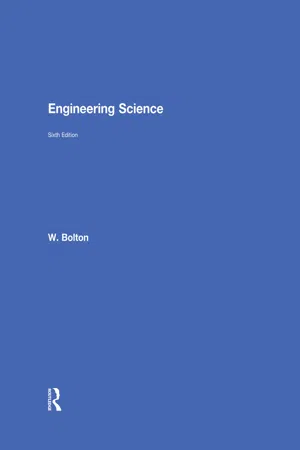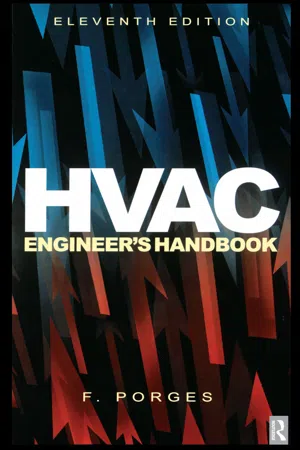Technology & Engineering
Joule Kelvin Expansion
Joule Kelvin Expansion refers to the increase in volume of a gas when it is heated at constant pressure. This phenomenon is described by the Joule-Thomson coefficient, which quantifies the change in temperature with respect to pressure. Understanding this expansion is crucial in various engineering applications, such as refrigeration systems and gas pipelines, where temperature and pressure changes are significant factors.
Written by Perlego with AI-assistance
Related key terms
Related key terms
1 of 4
Related key terms
1 of 3
3 Key excerpts on "Joule Kelvin Expansion"
- eBook - ePub
- W. Bolton(Author)
- 2015(Publication Date)
- Routledge(Publisher)
Chapter 8 Heat8.1 Introduction
Heat is defined as the transfer of energy that occurs between two systems when there is a temperature difference between them. As with other forms of energy, the SI unit for heat is the joule (J). This chapter is a basic introduction to the effects of heat transfer, namely temperature changes, changes of state, expansion and pressure changes.8.1.1 Temperature scales
Temperatures are expressed on the Celsius scale or the Kelvin scale. The Celsius scale has the melting point of ice as 0°C and the boiling point of water as 100°C. Temperatures on the Kelvin scale have the same size degree as the Celsius scale but the melting point of ice is 273.15 K and the boiling point of water is 373.15 K. Thus temperatures on the Kelvin scale equal temperatures on the Celsius scale plus 273.15. Temperatures on the Kelvin scale are usually denoted by the symbol T .8.1.2 Basic structure of solids, liquids and gases
A simple model of a solid is that of closely packed spheres (Figure 8.1(a) ), each sphere representing an atom. Each sphere is tethered to its neighbours by springs, these representing the inter- atomic bonds.Figure 8.1 A model of a solidWhen forces are applied to stretch a material, then the springs are stretched and exert attractive forces pulling the material back to its original position; when forces are applied to compress the material then the springs are compressed and exert repulsive forces which push the atoms back towards their original positions. These forces thus keep a solid in a fixed shape. If a solid is heated, the heat causes the spheres to vibrate and the higher the temperature the greater the vibration. At a high enough temperature the vibration is sufficiently vigorous for the spheres to break out of their close- packed array and the solid turns into a liquid. The spheres are still, however, close enough to each other for there to be weak forces which are sufficient to hold the spheres within the confines of a drop of liquid. Further heating results in an increase in temperature and the spheres moving about faster within the confines of the liquid as a result of gaining kinetic energy. At a higher enough temperature they have so much energy that they break free and the result is a gas (Figure 8.2 - eBook - ePub
- F. Porges(Author)
- 2013(Publication Date)
- Routledge(Publisher)
4
Heat and thermal properties of materials
Expansion by heat
Linear expansion is the increase in lengthL2 = L1 (1+et)Surface expansion is the increase in areaA2 = A1 (1+2et)Volumetric expansion is the increase in volumeV2 = V1 (1+3et)wheret = temperature difference (K) L1 = original length (m) A1 = original area (m2 ) V1 = original volume (m3 ) L2 = final length (m) A2 = final area (m2 ) V2 = final volume (m3 ) e = coefficient of linear expansion (m/mK) Sensible heat for heating or cooling
H = cM(t2 –t1 )whereH = Heat (J) M = mass (kg) c = specific heat capacity (J/kg K) t1 = initial temperature (°C) t2 = final temperature (°C) Expansion of gases
General gas lawPV = mRTR = (Cp – Cv )where
For airP = pressure (absolute), N/m2 (lbf/ft2 ) V = volume, m3 (ft3 ) m = mass, kg (lbm) R = gas constant, J/kg K (ft lbf/lbm K) T = absolute temperature, °K(°R) Cp = specific heat capacity at constant pressure, J/kg K (Btu/lb°F) Cv = specific heat capacity at constant volume, J/kg K (Btu/lb°F) R = 287 J/kg K = 96 ft lbf/lbm K = 53.3 ft lbf/lbm °F G = MR = universal gas constant which is the same for all gaseswhereG = universal gas constant J/kg K M= molecular weight of gas (dimensionless) R = gas constant for the gas J/kg K G = (C pm –C vm )whereC pm = specific heat capacity at constant pressure in J/kg mol K C vm = specific heat capacity at constant volume in J/kg mol K PVm = nGTwhere
In various unitsVm = volume of n moles n = number of moles - eBook - ePub
- John Bird(Author)
- 2019(Publication Date)
- Routledge(Publisher)
Thermal expansion and contraction are very important features in engineering science. For example, if the metal railway lines of a railway track are heated or cooled due to weather conditions or time of day, their lengths can increase or decrease accordingly. If the metal lines are heated due to the weather effects, then the railway lines will attempt to expand, and depending on their construction, they can buckle, rendering the track useless for transporting trains. In countries with large temperature variations, this effect can be much worse, and the engineer may have to choose a superior metal to withstand these changes. The effect of metals expanding and contracting due to the rise and fall of temperatures, accordingly, can also be put to good use. A classic example of this is the simple, humble domestic thermostat, which when the water gets too hot, will cause the metal thermostat to expand and switch off the electric heater; conversely, when the water becomes too cool, the metal thermostat shrinks, causing the electric heater to switch on again. All sorts of materials, besides metals, are affected by thermal expansion and contraction. The chapter also defines the coefficients of linear, superficial and cubic expansion. Thermal expansion is of importance in the design and construction of structures, switches and other bodies.At the end of this chapter, you should be able to:Science and Mathematics for Engineering. 978-0-367-2O475-4, © John Bird. Published by Taylor & Francis. All rights reserved.- appreciate that expansion and contraction occur with change of temperature
- describe practical applications where expansion and contraction must be allowed for
- understand the expansion and contraction of water
- define the coefficient of linear expansion α
- recognise typical values for the coefficient of linear expansion
- calculate the new length L 2 , after expansion or contraction, using L 2 = L 1 [1 + α (t 2 – t 1 )]
- define the coefficient of superficial expansion β
- calculate the new surface area A 2 , after expansion or contraction, using A 2 = A 1 [1 + β (t 2 – t 1 )]
- appreciate that β ≈ 2α
- define the coefficient of cubic expansion γ
- recognise typical values for the coefficient of cubic expansion
- appreciate that γ ≈ 3α
- calculate the new volume V 2 , after expansion or contraction, using V 2 = V 1 [1 + γ (t 2 – t 1 )]
31.1 Introduction
When heat is applied to most materials, expansion occurs in all directions. Conversely, if heat energy is removed from a material (i.e. the material is cooled) contraction occurs in all directions. The effects of expansion and contraction each depend on the change of temperature of the material.Thermal expansion and contraction are very important features in engineering science. For example, if the metal railway lines of a railway track are heated or cooled due to weather conditions or time of day, their lengths can increase or decrease accordingly. If the metal lines are heated due to the weather effects, then the railway lines will attempt to expand, and depending on their construction, they can buckle, rendering the track useless for transporting trains. In countries with large temperature variations, this effect can be much worse, and the engineer may have to choose a superior metal to withstand these changes. Accordingly, the effect of metals expanding and contracting due to the rise and fall of temperatures can also be put to good use. A classic example of this is the simple humble domestic thermostat, which when the water gets too hot, will cause the metal thermostat to expand and switch off an electric heater; conversely, when the water becomes too cool, the metal thermostat shrinks, causing the electric heater to switch on again. All sorts of materials, besides metals, are affected by thermal expansion and contraction. This chapter also defines the coefficients of linear, superficial and cubic expansion.
Index pages curate the most relevant extracts from our library of academic textbooks. They’ve been created using an in-house natural language model (NLM), each adding context and meaning to key research topics.
Explore more topic indexes
Explore more topic indexes
1 of 6
Explore more topic indexes
1 of 4


